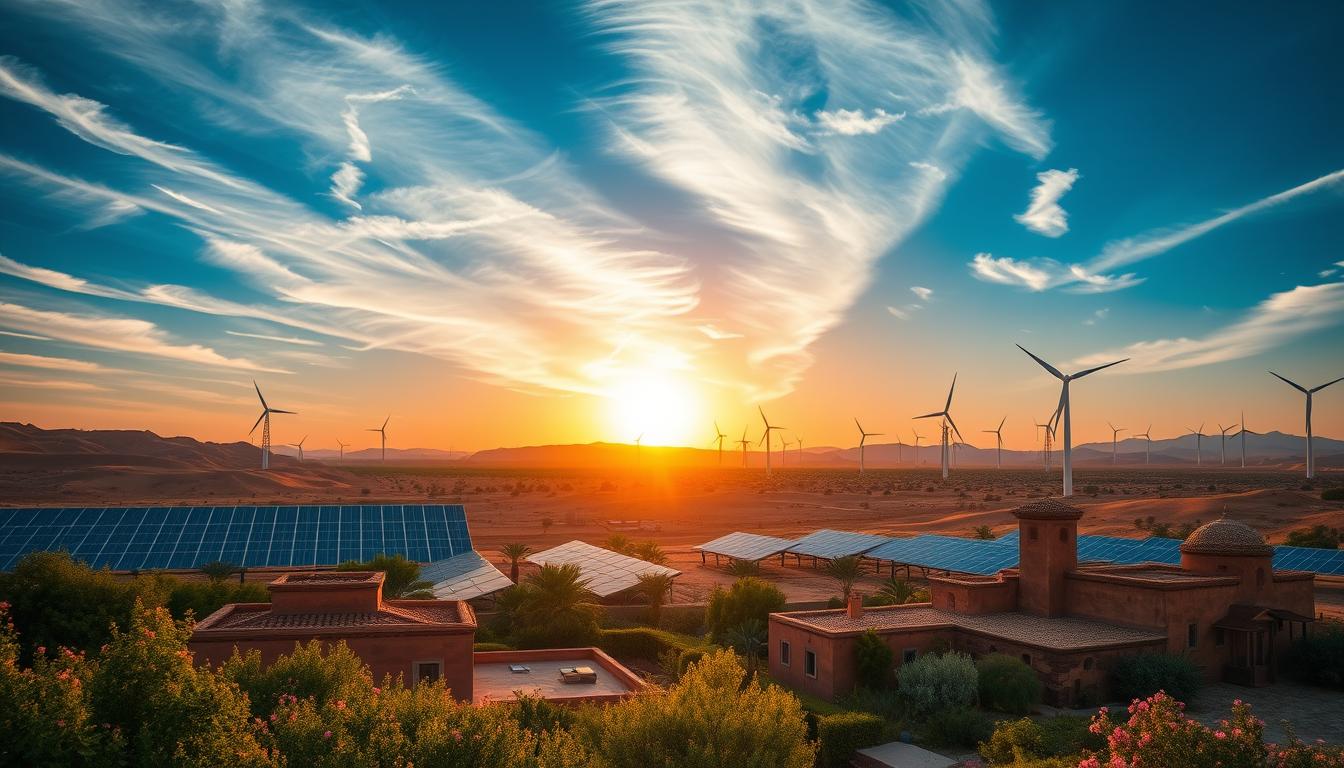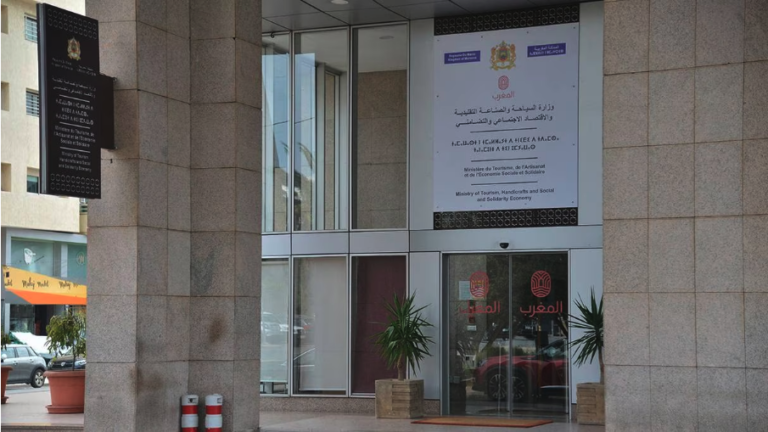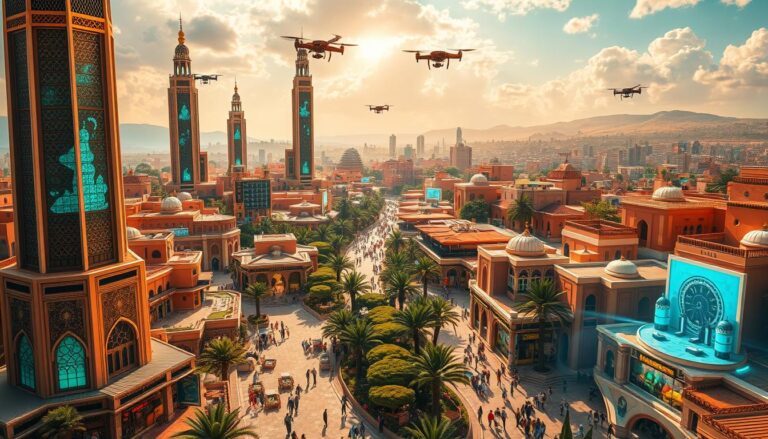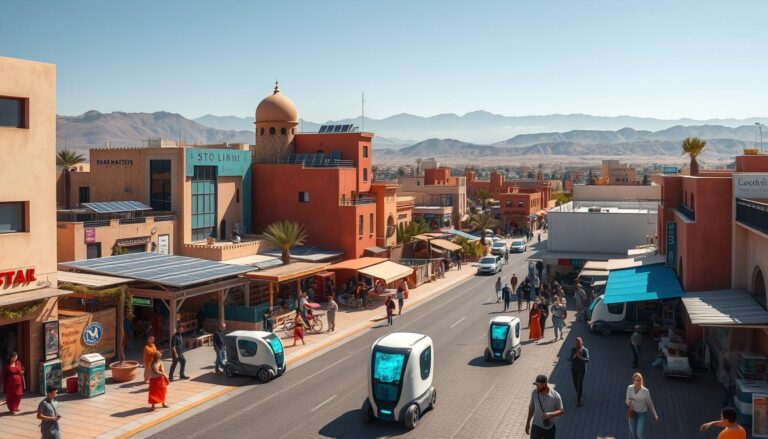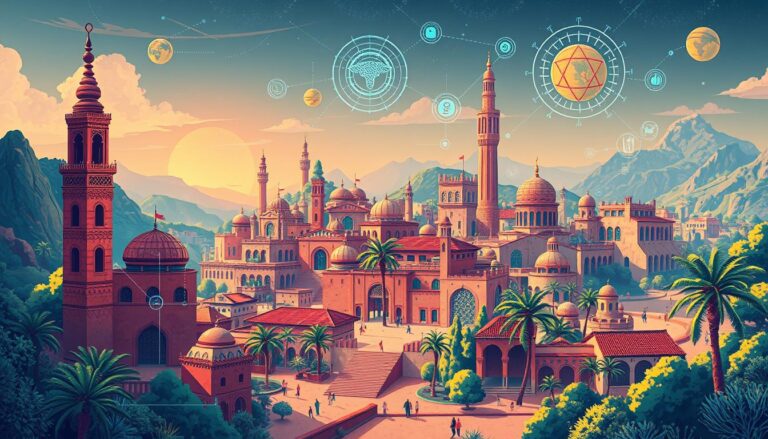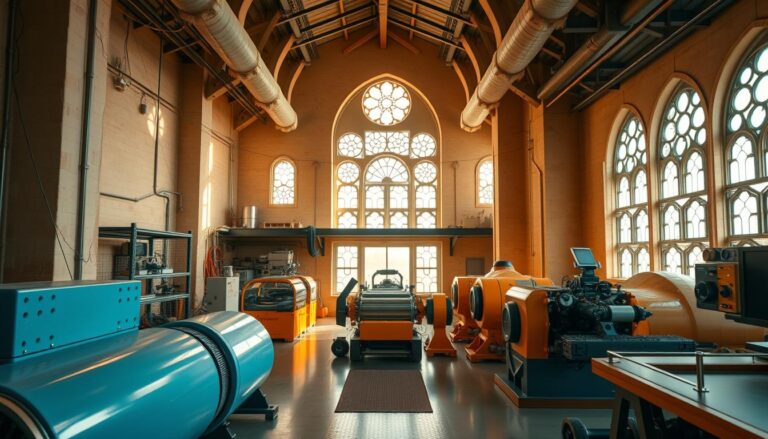Have you ever thought about how a country that imports a lot of energy can become a green energy leader? Morocco’s move to renewable energy is a story of big dreams, smart plans, and big changes. It’s part of a bigger effort in the Middle East and North Africa to fight climate change and grow the economy.
With the danger of global warming getting worse, Morocco’s change is more critical than ever.
This article looks at what drives Morocco’s green energy plans. It talks about the country’s big investments in solar and wind power. Morocco wants to get over 52 percent of its energy from these sources by 2030.
The challenge is big, but Morocco is trying to be more independent in energy. It wants to improve the economy, society, and deal with climate change. All this while facing ups and downs in fossil fuel prices.
Recent studies show a big jump in clean energy investments worldwide. Morocco’s journey is especially inspiring because it depends so much on imported energy. But with the right plans, Morocco could lead in sustainable energy in the region.
Join us as we dive into what’s pushing Morocco forward. We’ll see how it’s getting ready for a green, sustainable future.
The Drivers Behind Morocco’s Renewable Energy Ambitions
Morocco wants to use more renewable energy for good reasons. It imports a lot of energy and the prices can change a lot. This plan is to make Morocco’s energy safer and protect its economy.
Also, Morocco needs to manage its water better. Using renewable energy is a key part of this plan.
Morocco’s Energy Import Dependency
Morocco gets 90% of its energy from outside. This makes its economy weak. It costs a lot of money and slows down growth.
Using more renewable energy helps. It makes Morocco’s energy safer and more reliable.
Volatile Fossil Fuel Prices
Fossil fuel prices can change a lot. This is hard on people’s pockets and the country’s budget. It makes electricity and fuel more expensive.
Morocco is turning to solar and wind power. This helps keep energy costs stable and fights inflation.
Desalination and Water Scarcity
Morocco is short on water, ranking 27th in the world. It has to choose between homes and farms for water. This hurts its economy.
To fix this, Morocco is using renewable energy for desalination. This gives water and helps reduce fossil fuel use. It’s good for energy security too.
Massive Potential of Solar and Wind Energy in Morocco
Morocco is becoming a leader in renewable energy. It focuses on solar and wind power, using its deserts and coast. This makes it a top choice for renewable energy, ranked second in the world.
By using both solar and wind, Morocco is a role model for others. It shows how to build a sustainable energy future.
Solar Energy Projects
The Noor Ouarzazate Solar Complex is a key project in Morocco. It has 580 megawatts of power, enough for over a million homes. Solar power in Morocco has grown a lot, with a 16-fold increase in solar photovoltaic capacity by 2020.
Morocco’s sunny weather is perfect for solar power. It aims to use 20% of its electricity from solar by 2030. This shows Morocco’s dedication to renewable energy.
Wind Energy Projects
Wind energy in Morocco is also promising. The Tarfaya Wind Farm has over 130 turbines, providing 300 MW of power. This meets the energy needs of 1.5 million homes. The Midelt Wind Farm adds to this, showing Morocco’s commitment to wind energy.
Morocco’s geography is great for wind energy. With good policies and partnerships, wind energy will meet a lot of energy demands. This growth in wind projects helps Morocco’s renewable energy sector thrive.
The potential of solar and wind energy in Morocco is huge. By using these resources, Morocco is not just meeting its energy needs. It’s also creating a greener, more sustainable future.
Key Clean Energy Projects: Noor Ouarzazate
Noor Ouarzazate is a symbol of Morocco’s commitment to clean energy. It uses CSP technology advancements in Morocco to cut down on fossil fuel use and lower energy costs.
PV Solar Cells Cost Reduction
In the last ten years, PV solar cells have become much more affordable. What was once too expensive for many Moroccans is now within reach. This change is thanks to worldwide investments in solar technology.
This drop in cost is key for the Noor Ouarzazate energy potential. It helps supply electricity to the national grid and fights climate change.
Impact on Local Communities
Noor Ouarzazate does more than just produce energy. It deeply impacts local communities, showing the power of community-driven renewable projects. It creates jobs and improves local infrastructure, helping young people find work.
By offering reliable renewable energy, Noor Ouarzazate boosts local economies and improves lives for millions. It also sets a goal for Morocco to reach a 52% renewable energy mix by 2030.
Economic Benefits of Renewable Energy in Morocco
The rise in renewable energy projects has brought many economic benefits to Morocco. It boosts job creation and helps the local economy. Morocco plans to make renewable energy 52% of its power by 2030.
Job Creation
Morocco’s green growth has led to many job opportunities. Projects like the Noor Ouarzazate Solar Complex and Tarfaya Wind Farm have created thousands of jobs. This helps reduce unemployment and grows skills in the renewable energy field.
The clean energy job market in Morocco is growing fast. The Moroccan Agency for Sustainable Energy (MASEN) has launched big projects in 45 cities. Working with international partners helps transfer technology and create more jobs.
Boosting Local Economies
Renewable energy is making a real difference for local communities in Morocco. It boosts local economies by creating demand for services, materials, and labor. This activity helps small businesses and supports new ventures, making local economies more diverse.
Big investments in green energy, like MAD 23 billion for 2023 to 2027, will bring economic benefits. These investments improve renewable energy infrastructure and ensure economic growth.
As Morocco grows greener, its economy is changing. Renewable energy is becoming a key part of economic development. Morocco sees a future where green projects greatly boost GDP and lower youth unemployment.
Morocco’s Commitment to Sustainability Initiatives
Morocco is a leader in sustainability thanks to its strong policies and green projects. It aims to use more renewable energy and grow its economy. The country has a solid plan for renewable energy, helping it reach its goals.
Government Policies and Regulations
The “Morocco Offer” is key to the country’s green energy success. It plans to use 1 million hectares for green hydrogen projects. This will create jobs and new industries.
Morocco has already set aside 300,000 hectares for green hydrogen projects. These projects cover everything from making electricity to turning it into products like ammonia. This shows Morocco’s big investment in green technology and jobs.
By 2030, Morocco wants to get 50% of its electricity from renewables. Right now, 42% comes from green sources. To meet this goal, it will spend $9 billion on renewable energy and $4 billion on gas projects.
Morocco also plans to add 9 gigawatts to its power capacity. 7 gigawatts will come from renewable sources. This will help meet the country’s energy needs.
International Partnerships
Morocco’s green projects get a boost from international partnerships. Its location near Europe makes it a great place for green hydrogen. This attracts investors and technology companies.
For example, Morocco is working with the UK on the Xlinks project. It’s a $20 billion plan to build solar and wind farms in the desert. These will power over 7 million British homes by 2030.
Morocco is also teaming up with the UAE on a big gas pipeline project. This project will transport Nigerian gas across 13 countries. Such partnerships help Morocco’s green energy plans and boost its global reputation.
Morocco’s green policies and international partnerships are a great example. They show how to effectively tackle sustainability challenges. These efforts help both the local community and the planet.
Sustainable Development in North Africa: Morocco’s Leadership
Morocco is a leader in North Africa’s push for sustainability. It aims to have over 52% of its electricity from renewable sources by 2030. This goal shows Morocco’s commitment to the environment and sustainable growth.
The country’s strategy is to balance development with protecting the environment. Morocco tackles challenges head-on, focusing on renewable energy. It’s setting a high standard for sustainable development in North Africa.
Regional Comparisons
The MENA region faces big challenges like fast population growth and high joblessness. Morocco stands out with its bold plans for renewable energy. Its strategy includes a low-carbon plan for 2050, aiming to boost GDP by up to 15%.
Compared to others, Morocco leads in clean energy. It has the right infrastructure, laws, and funding for green projects. This makes Morocco a key player in the energy shift in the MENA region.
Environmental Impact
Morocco’s plan goes beyond just using more renewable energy. It wants to make energy use more efficient and support sustainable farming. This will greatly reduce its carbon emissions.
The country hopes to cut greenhouse gas emissions by over 2.6 billion metric tons by 2050. It also plans to create 100,000 to 350,000 jobs in sustainable projects. Morocco’s efforts are inspiring other countries in the MENA region to follow its lead.
The Role of Green Hydrogen in Morocco’s Energy Future
Green hydrogen is key to Morocco’s energy future. It’s driven by the country’s rich renewable resources and partnerships. This sector is promising, using Morocco’s solar and wind power. It aims to be a major player in the global energy market.
Production and Export Potential
Morocco’s location near Europe is a big plus for green hydrogen. The Noor Ouarzazate Solar Complex and Tarfaya Wind Farm show Morocco’s commitment to renewable energy. With these resources, Morocco could become a big exporter of green hydrogen.
The government’s focus on renewable energy and green hydrogen is attracting investments. This sets the stage for large-scale production and export facilities.
Collaborations with the EU
The EU partnership boosts Morocco’s clean energy export chances. The “Morocco-EU Green Partnership” signed in October 2022 highlights Morocco’s role as an energy hub for Europe. Working with leaders in hydrogen technology is crucial for making green hydrogen production efficient and affordable.
Through the “Morocco’s Offer” project, the country aims to develop green hydrogen. It also wants to create sustainable trade routes. This will have a big impact on the global fight against climate change.
Challenges in Morocco’s Green Energy Transition
Despite Morocco’s big steps in green energy, the path to a sustainable future is tough. Overcoming financial hurdles in renewables is key to reaching their goals.
Initial High Costs
The high costs of starting renewable energy projects are a big problem. Morocco aims to use 52% of renewable energy by 2030. But, they need a lot of money upfront.
They plan to spend over USD 40 billion on energy projects by 2030. Most of this will go to renewables. Finding ways to finance these projects is a big challenge. Banks and international partners must help.
Infrastructure and Technological Constraints
Building the right infrastructure for clean energy is another big challenge. Morocco needs a strong, reliable system to support its renewable energy plans. The current grid must be updated to handle solar and wind power.
Also, technological barriers in green transition need to be overcome. Morocco’s Green Energy Park will lead in research and development. It aims to solve these problems.
The park will focus on making energy use efficient in different areas. This includes transport, homes, industry, farming, and street lights. It shows how big the challenge is to build the right infrastructure for clean energy in Morocco.
The Social Impact of Morocco’s Green Energy Projects
Morocco’s green energy projects do more than cut carbon emissions. They improve life quality, public health, and education across the country.
Improving Quality of Life
Morocco’s move to renewable energy will greatly enhance life quality. It plans to get 52% of its power from solar and wind by 2030. This will give more people access to affordable, clean electricity.
This is especially good for rural areas. It lets them join the bigger economic and social world.
Projects like the Noor Solar Complex in Ouarzazate will also cut CO2 emissions by 762,000 tons yearly. This will make living spaces healthier. Morocco’s focus on sustainable energy shows its dedication to improving life for its people.
Health and Education Benefits
Morocco’s green energy projects have big health benefits. They help reduce air pollution and diseases linked to it. Cleaner air means better health for everyone.
Education also gets a boost from clean energy. Schools get steady power for learning tools. This leads to better grades and a more skilled workforce.
Morocco’s renewable energy efforts have a wide impact. They improve living conditions, health, and education. By investing in green energy, Morocco is building a sustainable future for its people.
Conclusion
Morocco is moving towards a greener future with a clear vision. It aims to use 42% renewable energy by 2020 and 52% by 2050. This shows a strong commitment to sustainable energy.
This change is key to reducing its energy import dependency, which is currently 94%. It also aims to create a strong, self-sufficient economy.
Morocco’s move to sustainable energy will bring many benefits. It will improve the environment and boost the economy and society. From 2000 to 2020, renewable energy use grew from 6% to 19%.
Projects like Noor Ouarzazate show the impact of big investments. They can create jobs and help local economies grow.
Clean energy is Morocco’s path to progress. The country has made big investments and changed its energy policies. Ending fuel subsidies in 2014-2015 helped fund renewable projects.
Morocco plans to cut greenhouse gas emissions by 45.5% by 2030. This sets a high standard for other countries. Morocco’s approach to energy security is a model for a greener, more resilient future.
Source Links
- Just Energy Transitions? Lessons From Oman and Morocco
- Morocco – Energy
- Morocco’s Energy Transition: Prioritizing Natural Gas, Embracing Green Hydrogen, and Global Collaboration at COP28
- Morocco’s sustainable energy transition and the role of financing costs: a participatory electricity system modeling approach – Energy, Sustainability and Society
- Morocco’s path to a climate-resilient energy transition: identifying emission drivers, proposing solutions, and addressing barriers
- Climate Resilience for Energy Transition in Morocco – Analysis – IEA
- How Morocco went big on solar energy
- Morocco making waves with its green energy progress
- Four Reasons Why Morocco Is Becoming a Renewable Energy Powerhouse
- A shining example of green energy in Morocco
- Environmental impact study of the NOOR 1 solar project on the Southern Region of Morocco
- OUARZAZATE
- Renewable Energy and Economic Growth in Morocco
- Investment Opportunities in Morocco’s Energy Sector
- Morocco’s Renewable Energy – İnsamer – İnsamer
- Morocco’s Strategic Move in the Green Hydrogen Sector: Unveiling the "Morocco Offer"Article
- Morocco reveals strategy to speed up energy transition | AGBI
- Roadmap for a low-carbon transformation in Morocco
- Morocco and the Future of Green Hydrogen
- Morocco and the European Union move forward together on green hydrogen regularisation
- Morocco’s energy transition
- Morocco: New Prospects for Clean Energy Development
- Climatech MEA – Morocco’s Energy Challenges Despite Large Scale Renewables Projects
- The Rise of Renewable Energy in Morocco – Alafarika for Studies and Consultancy
- Morocco’s National Energy and Energy Efficiency Plan | Inequality Solutions
- Green energy security assessment in Morocco: green finance as a step toward sustainable energy transition
- Morocco’s Future Energy: The Path Forward | ISPI
- No title found

The Editorial Team is a passionate group of Morocco enthusiasts dedicated to sharing the beauty, culture, and wonders of this captivating country. With diverse backgrounds and a deep love for travel, we strive to bring you engaging and informative content that inspires your Moroccan adventures. From uncovering hidden gems and sharing local insights to exploring mouthwatering cuisine and showcasing the vibrant lifestyle, our team is committed to providing you with valuable resources and exciting stories that enhance your exploration of Morocco. Join us on this journey as we celebrate the rich heritage and unforgettable experiences that make Morocco truly special.

